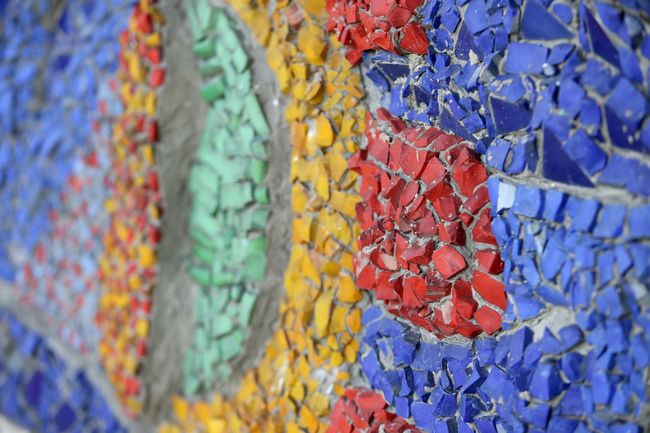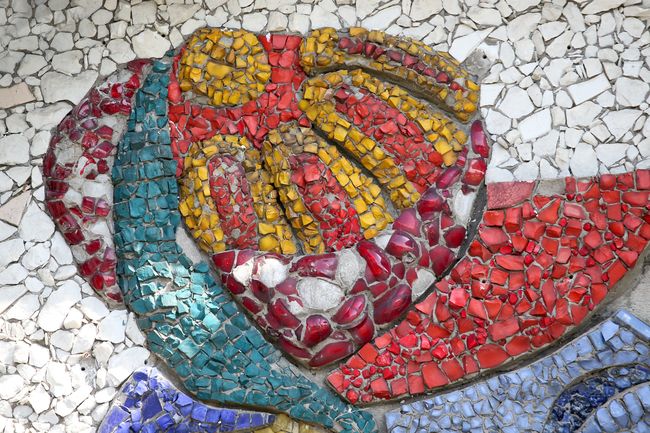A billboard covered the mosaic “Wind” at 11, Akademika Hlushkova Avenue, for many years. When a new restaurant, Mill Hub, put up its banner, this revolted a lot of Kyivites (Den wrote about this situation in “We Are in the Art Wilderness,” No. 86, May 24), and – a unique case – the management quickly restored the building’s original facade. The mosaic was opened for everyone to see. The people who gathered, including those who know the oeuvre of “Sixtiers,” activists, and ordinary residents of Kyiv, were not only feasting their eyes on the picture, but also discussing the preservation of cultural heritage.
THE TRACE OF UKRAINIAN ART IN THE DONBAS
Liudmyla Ohnieva, who has researched the artist’s oeuvre for about 20 years, calls Alla Horska and her colleagues Viktor Zaretsky, Halyna Zubchenko, and Hryhorii Synytsia prime movers of the revived Ukrainian monumentalism in the 1960s. In the mosaics they created in the Donetsk region, they turned to the traditions of the previous generations of masters and also used Ukrainian traditional symbols and motifs from myths about the creation of the world. The energy of the elements and cosmic symbols beamed on the walls of monotonous-looking buildings of that era.

However, communist party functionaries were trying to squeeze the artists’ creative projects into their own framework. It was forbidden to display the picture “Ukraine” in Donetsk, for it was allegedly not in line with the region’s specifics. They had to replace it with the image of local “Prometheuses” – a coalminer and a steelmaker. But the authors still managed to organically bring it into line with the mosaics that had Ukrainian subtexts. These works are a noticeable trace of Ukrainian art in the Donbas, another thread that links it with the other regions of Ukraine. The artists were not only carrying out custom-made projects there – some of them had lived and worked in the Donetsk region for many years.
DISPOSAL OF MEMORY
The efforts of artists were far from always duly appreciated. After the murder of Alla Horska, her name was effaced from public mind all over the Soviet Union. It was almost never mentioned that she was one of the authors of the Young Guard mural at the Krasnodon Museum. In independent Ukraine, too, the successors of Party functionaries would give permission to ruin mosaics in the course of renovation, saying, for example: “A tram stop is the best place for it.” The monumental complex at Donetsk School No. 5 was in poor condition well before the hostilities began in eastern Ukraine, but the money for its restoration was lost among the cogs of the bureaucratic machine. The mosaic in the building of the former downtown Rubin store was on the point of ruination, when the latter was being renovated for a new Macdonald’s.

Out of the three Mariupol mosaics, only one – the mural “Ukraine” – is now free to be watched. The restaurant that had the mosaics “Arbor Vitae” and “Kestrel” went private after the collapse of the USSR. They are hidden from the human eye now, albeit preserved in a good condition. A similar fate befell the artworks the “Sixtier” created in Kyiv.
THE “RELAY RACE” OF INDIFFERENT OWNERS
In the 1960s, Ukrainian architects also turned to ethnic motifs, combining them with modernistic trends. Architect Anatolii Dobrovolsky designed three restaurants – Kureni, Poltava, and Vitriak – for Kyiv. Alla Horska and her fellow artists were also involved in the two latter projects.
The restaurant Poltava was torn down in 2008, while Vitriak and the mural “Wind” (“Viter”) on it have survived, although the interior was completely redesigned. This restaurant was built on what were Kyiv’s outskirts at the time. But now it is surrounded by the high-rises of the Teremky housing neighborhood. In the past few years, the structure has housed the Route 66 bikers’ club, whose owners covered the mosaic with their banner and damaged it with fasteners. As the new owners were coming, the wall remained open and the public heaved a sigh of relief – Kyiv’s only mural by Alla Horska was intact and seemed to be in full view of the public. However, quite in the tradition of its predecessors, the new establishment, Mill Hub, has hidden the mosaic behind the wall that bears its name.

Art critic Yevhenia Moliar, who accidentally saw the result of this renovation, raised the alarm. She wrote about this in Facebook, and her post triggered a stormy reaction of users. Journalists also paid attention to the situation. Luckily, the restaurant management responded quickly and politely – they got in touch with Moliar and promised to remove the wall and reopen the mosaic. They kept their promise.
TO UNDERSTAND AND TO ACCEPT
Mill Hub’s design fits in with brand-new highrises a few meters away. Lots of white color complemented with deep brown hues, a summer ground with a fountain, sunshades and armchairs, a lawn near the entrance… The mosaic “Wind,” which reflects folk painting motifs, adds a historical streak to modern-day interiors. The owners have also set a plaque with a brief description of the mural under the restaurant’s banner. Moliar, who wrote the description, is sure that this will not only make Mill Hub more interesting to city residents, but also help harmonize the Soviet-era mural heritage with today’s urban space.
The restaurant owners warmly welcomed all those who came to see the opened mosaic. On a closer examination, it is clear that “Wind” was considerably damaged due to time and carelessness of the previous owners but the mosaic can still be saved by an efficient restoration. It is not known whether the restaurant will bear the expenses, but the management has promised to “Ukrainize” the place with lectures, exhibits, and other cultural events.
It is one of the few positive examples of a community managing to protect monuments of architecture and mural art. There is a particularly difficult situation with the Soviet-era heritage. Buildings and their ornamentation are being spoilt relentlessly, with no protective status granted. The carelessness of owners also contributes to this. A glaring example is the Kyiv Riverside Station that remains deserted and is gradually ruining before the eyes of the public that has already heard endless promises of reconstruction.

The mechanism of granting protective status to mosaics and paintings has not been finalized, but even its juridical finalization will not guarantee that mural artworks will survive under the pressure of de-communization. There has long been a talk about the museum of monumental art (in other versions – of propaganda), but this idea often has a negative connotation. But the truth is that, in addition to ideological load, which, incidentally, occurs far from everywhere, some objects have artistic value which it is easy to lose because of barbarian approaches.
Naturally, the public is becoming more active and attentive, applies multimedia technologies, and reacts faster to violations. Yet every ordinary individual is not an art expert (even officials can stoop to “bus-stop reasoning”), and you can’t possibly keep an eye on everything. So it is better to put protecting and assessing the value of monuments on a professional – both cultural and legislative – level.








